Extreme Pro Street HEMI® Daytona
— 2,500-horsepower alcohol HEMI® race engine
— 4130-chromoly tubular race chassis with 4-link rear suspension
— Fully street-legal and also IHRA Pro Mod certified for competition
The Dodge Daytona from 1969 is an iconic vehicle and known for what it did on the NASCAR superspeedways. However, when deciding to build a radical Mopar® “Pro Street” car from scratch, the wilder the better was what Wally Elder of St. Louis, Missouri, was after, and the winged Dodge Daytona with extended front nose fit the bill, perfectly! Oh, and of course a supercharged HEMI® engine! This is a high-caliber build behind all that PPG Code 81 Red paint! And the owner is no stranger to custom painting and superb auto body work, he’s been in the business for some 36 years (Custom Auto Works, Dittmer, MO)!
The story of Wally and a Dodge Daytona Pro Streeter actually goes back to 1991. At that time, he was able to obtain an Alston chassis kit (117-inch wheelbase for Mopar B-body), Pinto front suspension and rack and pinion steering, 8 3/4-inch Mopar rear end with Detroit locker, and the car featured an alcohol-fueled Gen I 392 HEMI engine topped with a BDS 6-71 supercharger, Enderle fuel injection, 727 TorqueFlite®. 15 x 4, 15 x 14 Weld Racing wheels, done up in Red with White Daytona stripe. A real radical ride in the day, so much that Hot Rod Magazine considered it a “Top Ten” car for 1991.
All these years later, here’s how Wally describes his former car and how this “replacement” car came about: “In the early 1990s, I built a 1969 Dodge Daytona Pro Street. It had a blown alcohol-injected 392ci HEMI. It was featured in a bunch of magazines back in the day. Unfortunately, I sold the car a few years later and lost track of it for many years. I always regretted selling it and decided I would try to locate it. My friend Tony took out a bunch of ads on Craigslist in the area where I sold the car. About a year later, someone contacted him and said a friend of theirs had the car and put us in contact with him. I tried to get him to sell it back to me with no luck. So I decided to build a new car similar to it and make it better than the first one. And here we are!”
BETTER AND MORE POWERFUL!
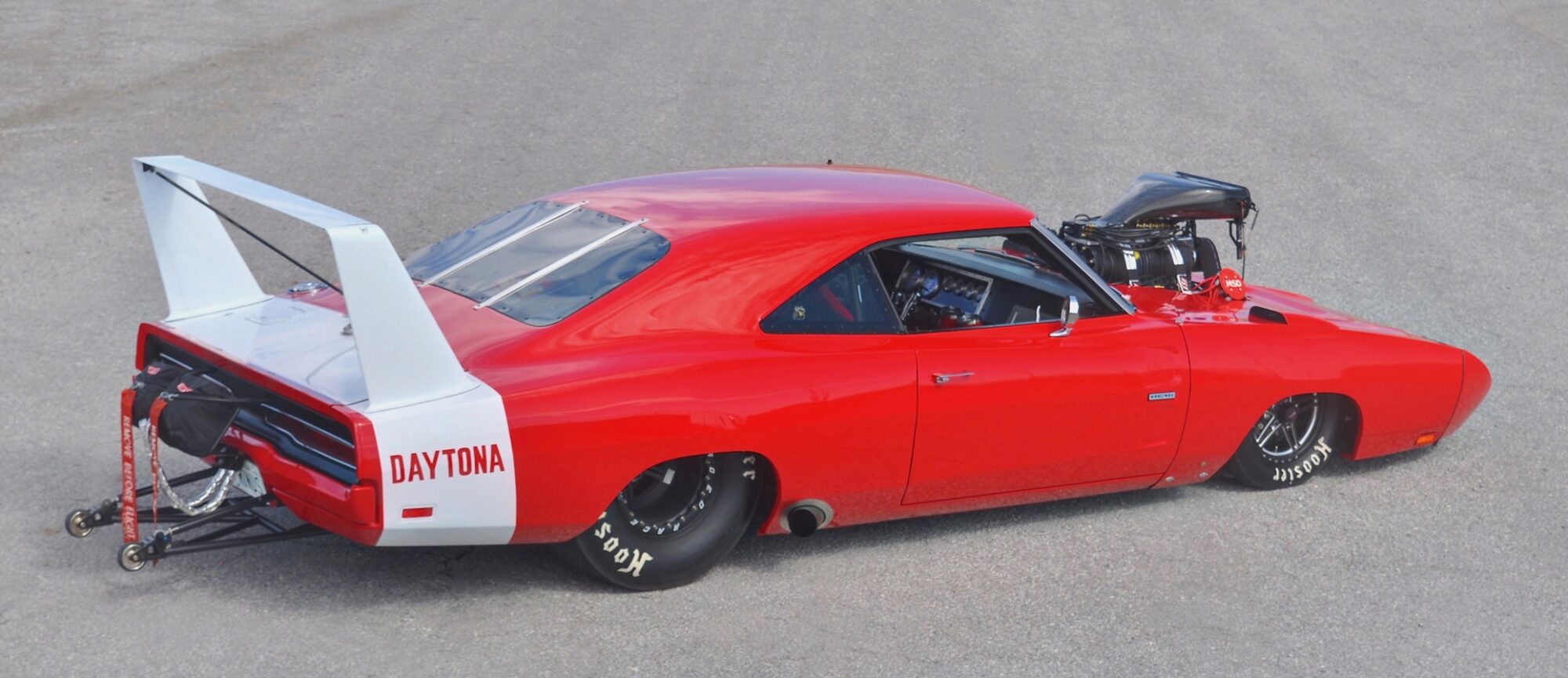
At first glance, Wally’s new HEMI engine-powered Daytona has the very same “Pro Street” flavor as his first build; however, this newly created version has a much more serious powerplant, and with updated components front to rear. The Charger Daytona body shape has an obvious aerodynamic look to it, with its pointed nose that adds 18 inches to the overall length, and that massive rear wing that stands some 23.5 inches tall. Add in a modified rear window (where the slope was changed from standard Charger 45 degrees to more streamlined 22 degrees), plus the front fender reverse scoops, A-pillar covers, yes, a special NASCAR body that Buddy Baker broke the 200-mph barrier with back in the glory days of stock car racing!
Back in 1969, when the winged Dodge Daytona was being designed, all that mattered to Dodge’s General Manager was if it would win races … which it did, and so did the Plymouth “Superbird” version for 1970. All these years later, and with the amount of detail and effort that Wally Elder has put into the project, you got to imagine the “high fives” that all that were involved in the originals would be giving it right now!
REAL RACECAR CHASSIS
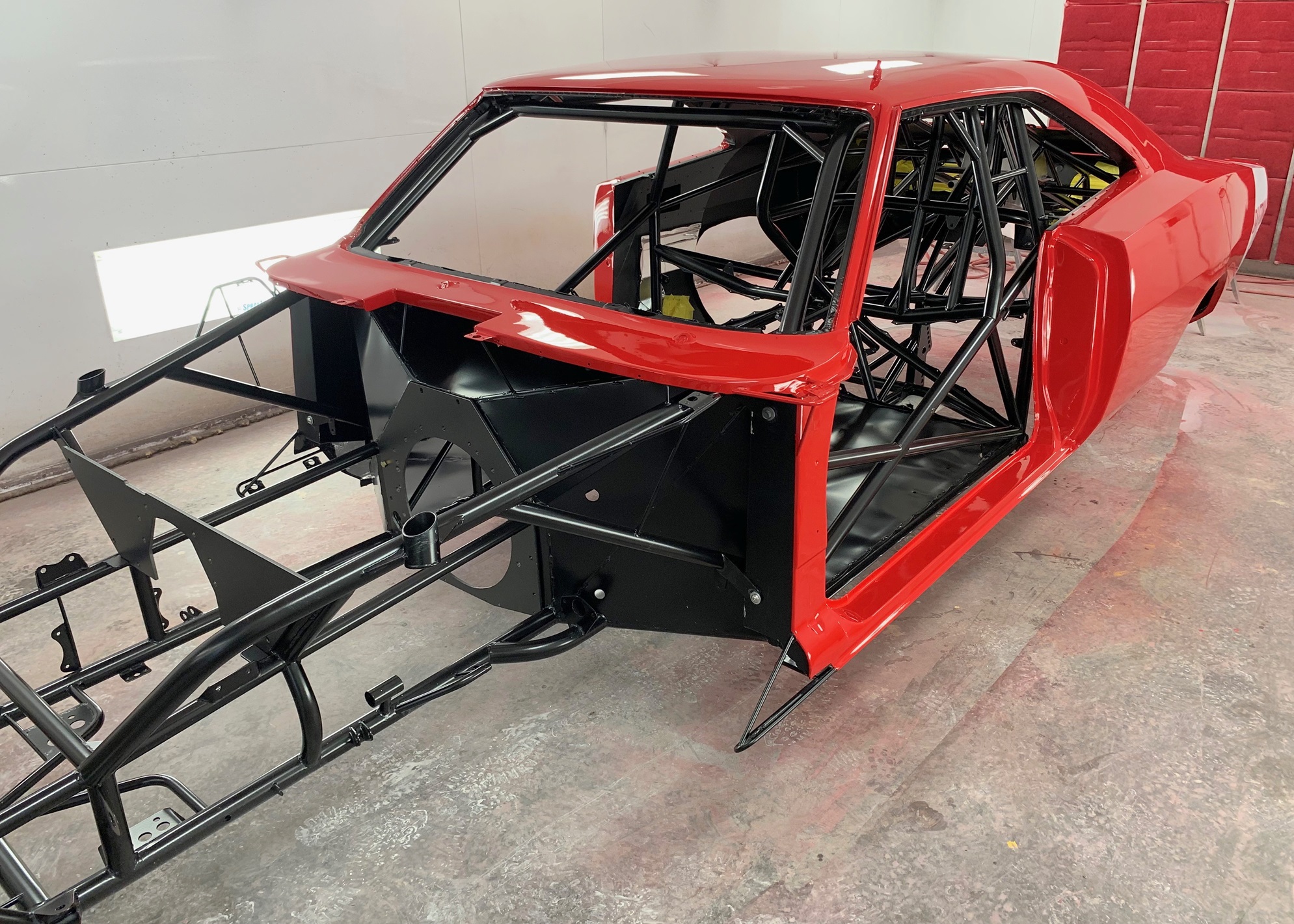
The inner skeleton of the car is a SFI-certified “double rail” Pro Mod chassis, competition-legal as fitted with the driver’s Funny Car enclosure welded into the roll cage. As designed for this application, it was fabricated to provide the space for a passenger’s seat installed! All done with 4130 chromoly tubing.
BODY COMPONENTS
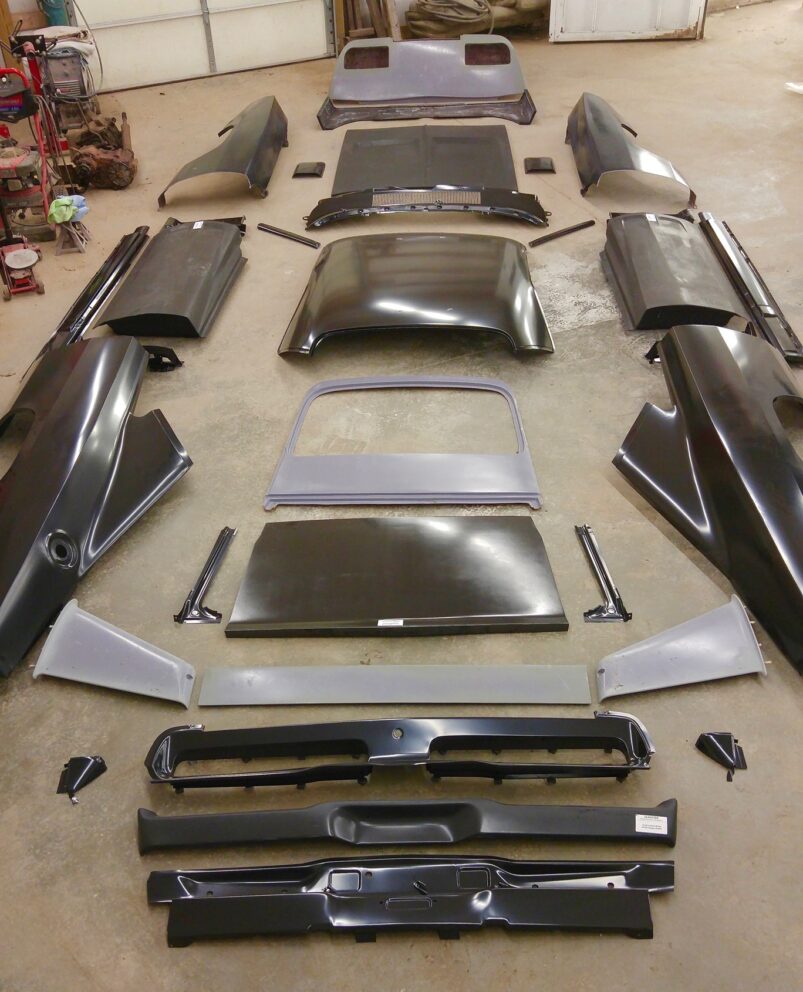
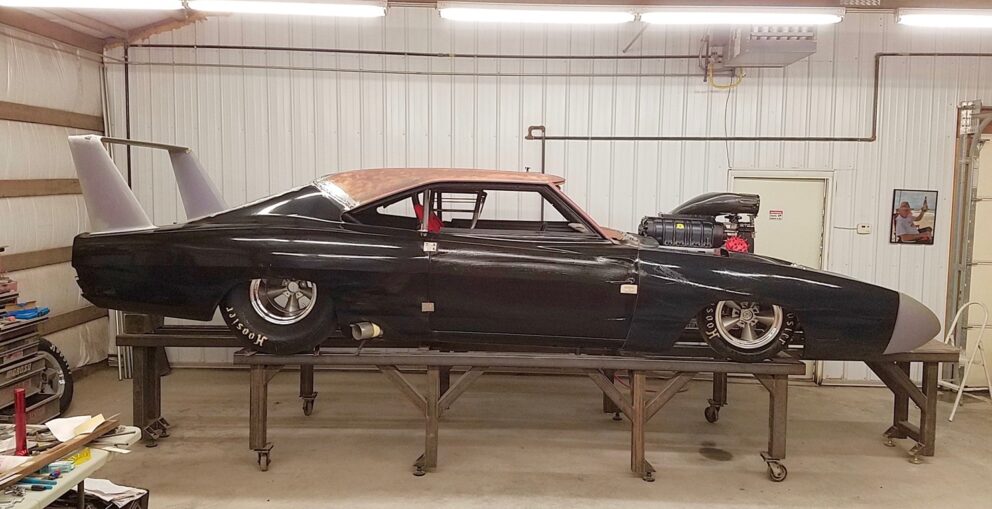
The body components are all fiberglass items, save for the roof panel. The original plan was to use a metal reproduction roof; however, the decision was made to incorporate a stock Charger roof (incorporating the drip rails, A-pillar posts) and the cowl panel also an original body.
The mockup of the car shown here reveals the 1.5-inch “droop” of the front fenders (created with a pie-cut at the door and sectioning above the wheel openings), done up in a fashion that very well could have happened back when these winged warriors were racing.
ALL-ALUMINUM HEMI ENGINE
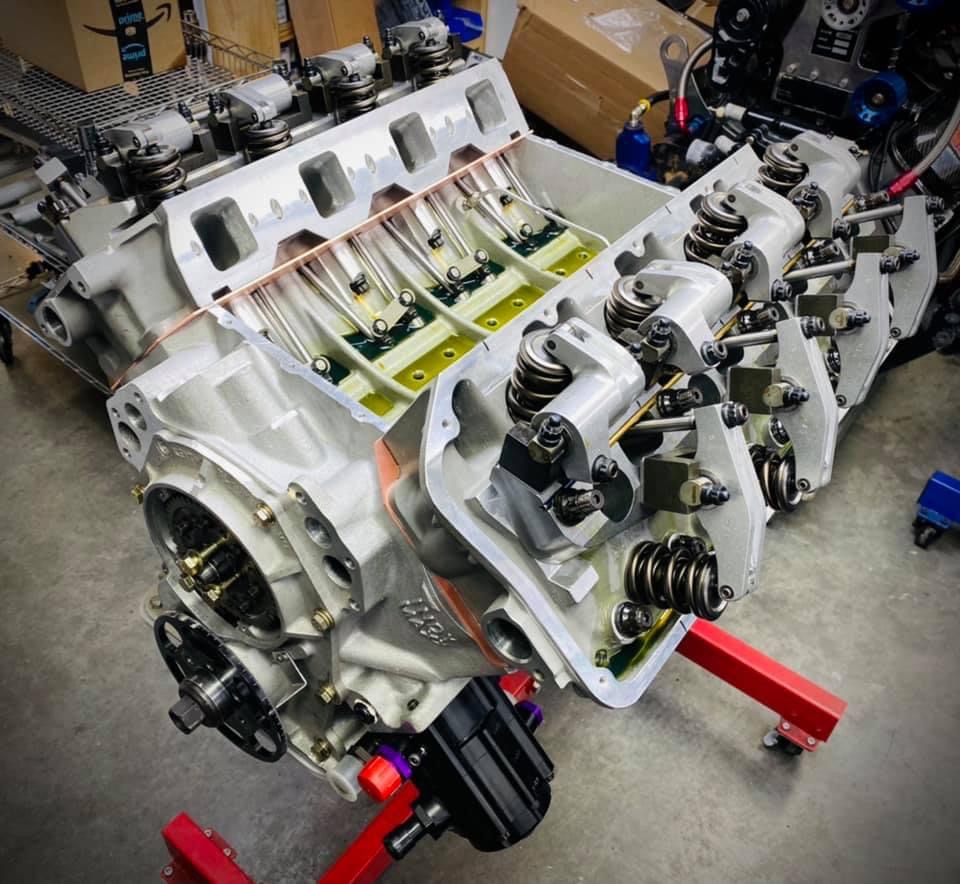
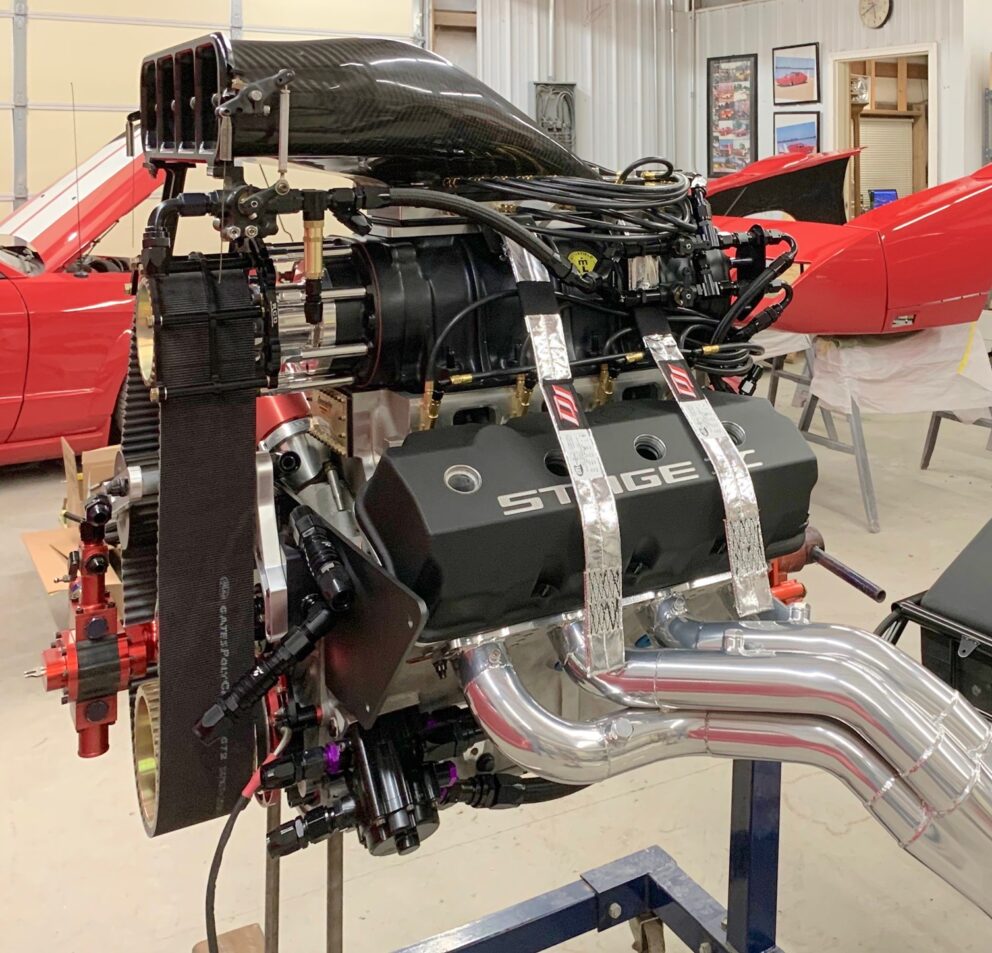
This is an Indy Maxx aluminum block, water jacketed and with raised cam, Bryant Racing billet crank, Brooks rods, JE pistons, 54mm roller Comp Cams camshaft, Stage V aluminum raised port cylinder heads, (fitted with Ray Barton / T&D Machine rocker arms, Comp Cams valve springs, Victory 2.4-inch intake, Manley 1.90-inch exhaust valves). Clark custom copper head gaskets. Keith Black gear drive, P&P dry sump oil pump, Moroso pan, System 1 filtration, all these internals are suitable for Top Fuel and Top Alcohol drag race applications. Built and component designed by Bullet Racing Engines (House Springs, MO).
When the assembly is topped off with a mammoth 14-71 high helix roots supercharger from Littlefield Blowers, with all the trimmings, custom owner-fabbed headers (2 5/8-inch primaries, 5-inch collectors) there’s little question that this jumbo 526-cube GEN II HEMI engine is not the everyday engine seen in Mopar muscle cars!
DANA 60 RACE-PREPPED REAR END
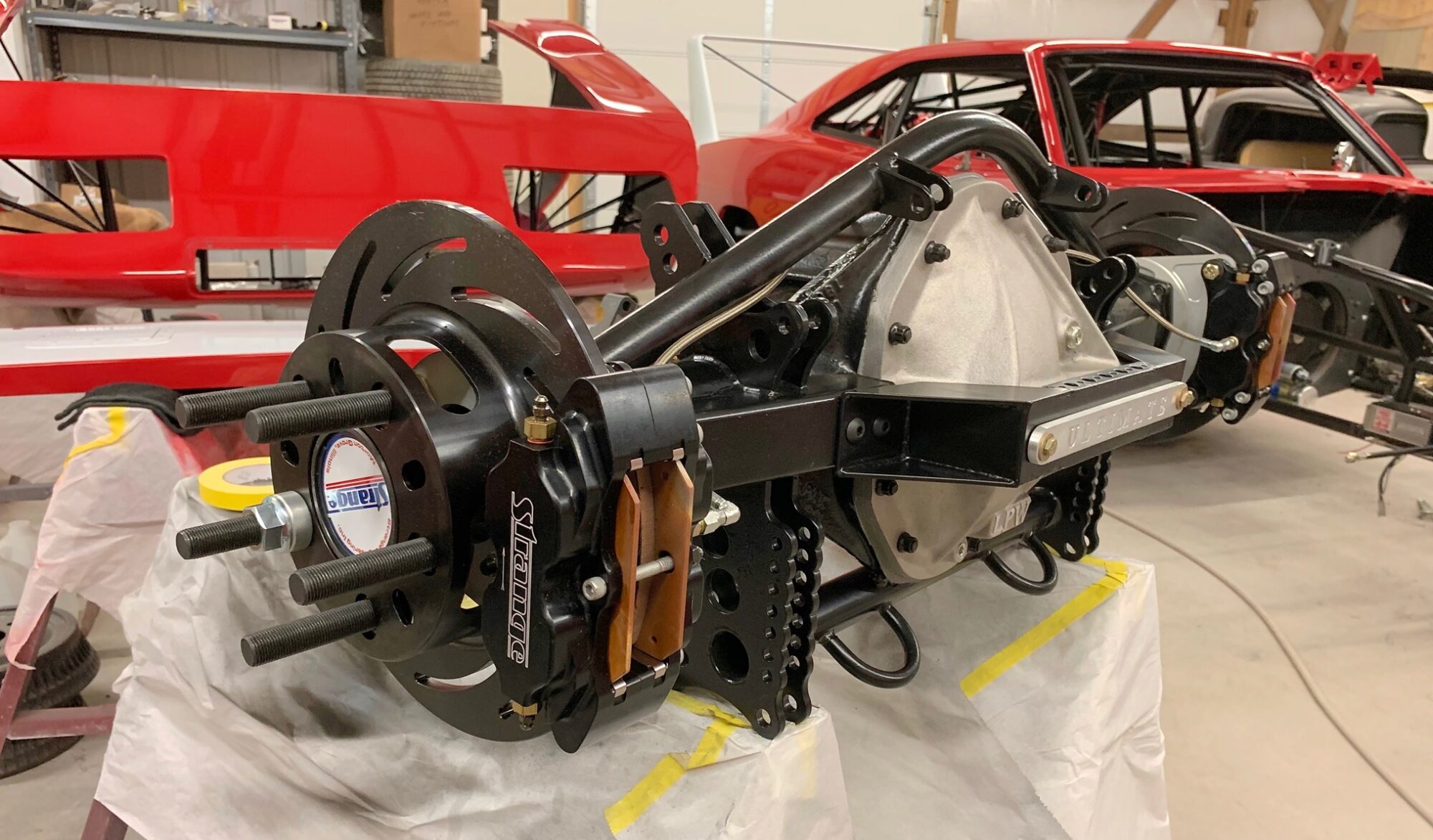
The Dana 60 rear axle with its large 9.75-inch diameter ring gear has long been favorites with the Mopar muscle car world, and they were factory fitted with low gear ratio 4-speed HEMI engine and 440 cars from the factory. This one has 40-spline axles and spool from Strange Engineering, 4.10:1 US Gear ring & pinion, is fortified with beefed housing and an LPW Ultimate aluminum cover. Big disc brakes (to aid in holding the monster at signal lights and traffic!) along with mounts for 4-link rear suspension and wheelie bars.
WHEELS/TIRES
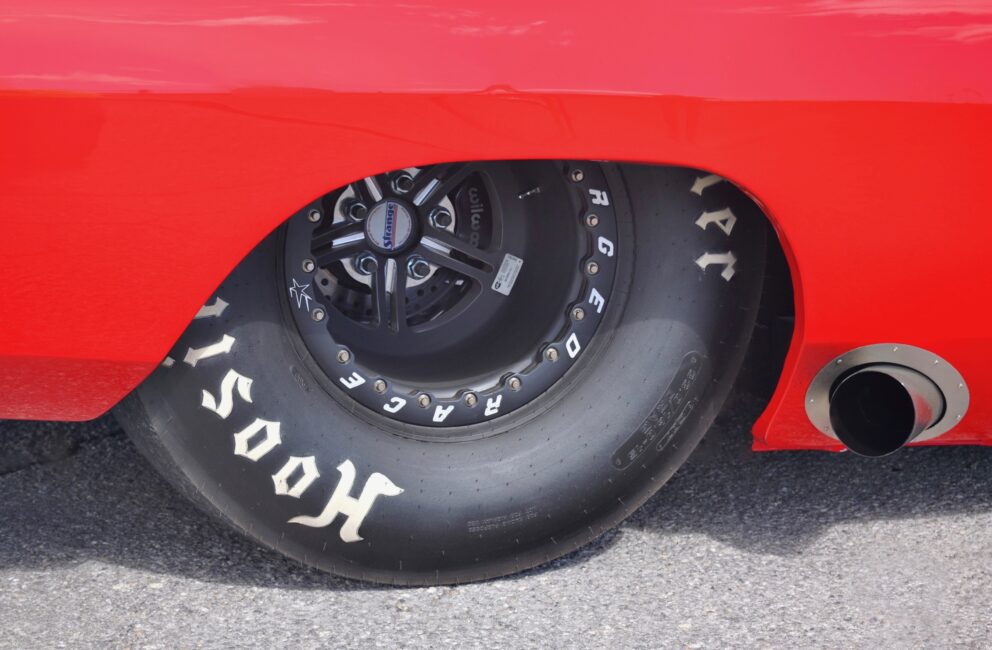
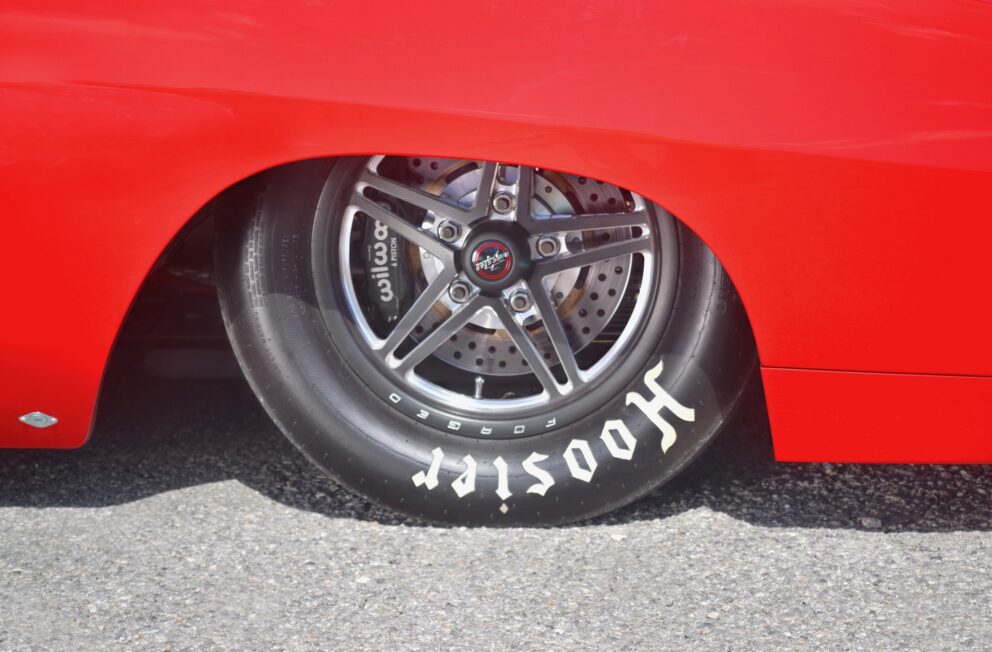
Front wheels are 15×4-inch Forged Race Stars wrapped with 25 x 4.5-15 Hoosier Quick Time Pro tires, out back some serious rubber: 33.0/16.0-15 Hoosier Pro tires with 15 x 15 Forged Race Stars with double bead locks..
INSIDE THE CABIN
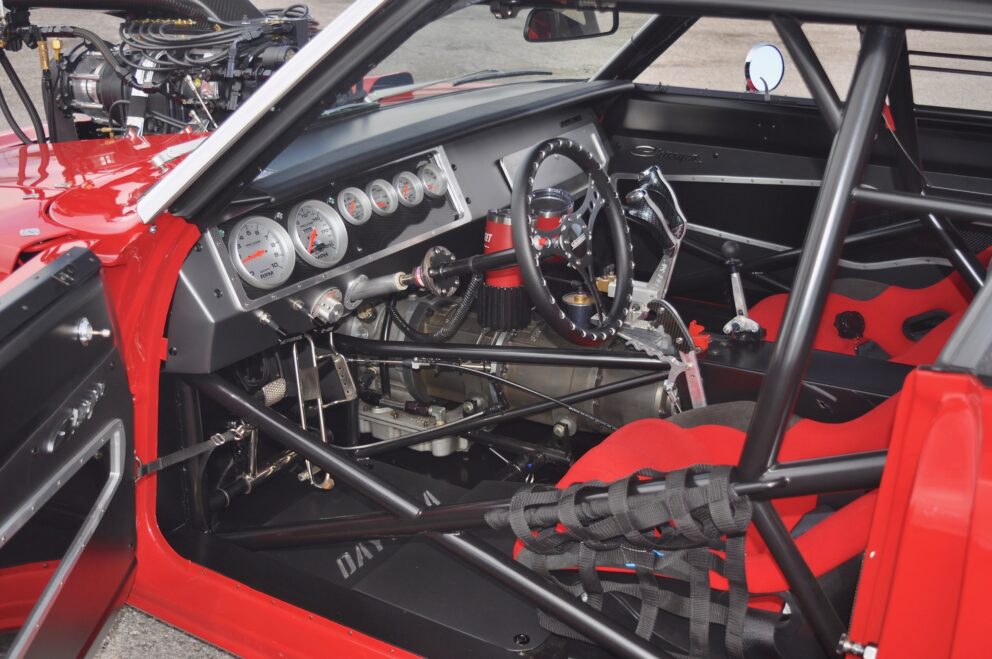
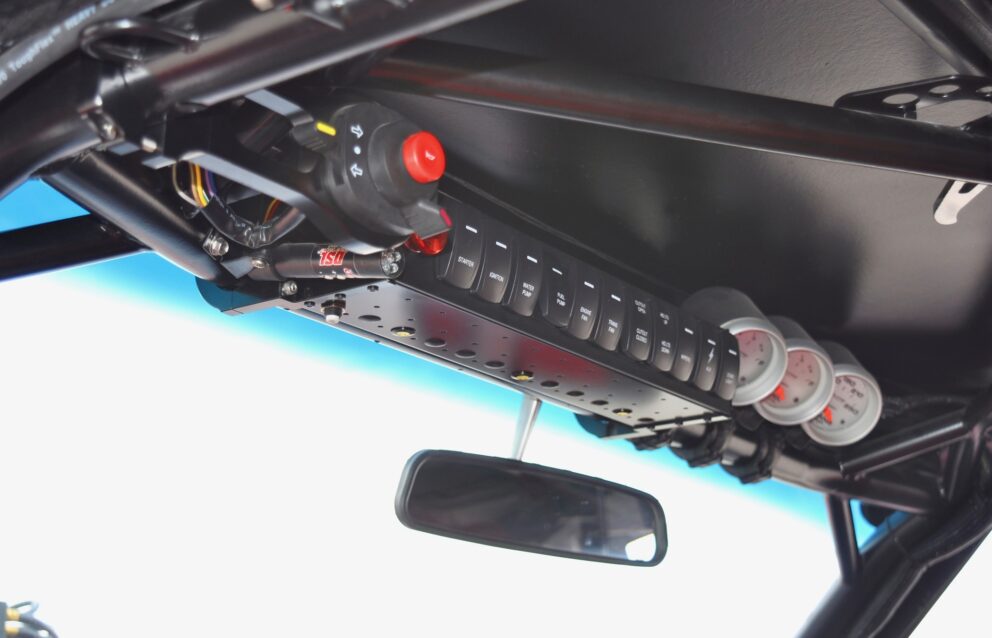
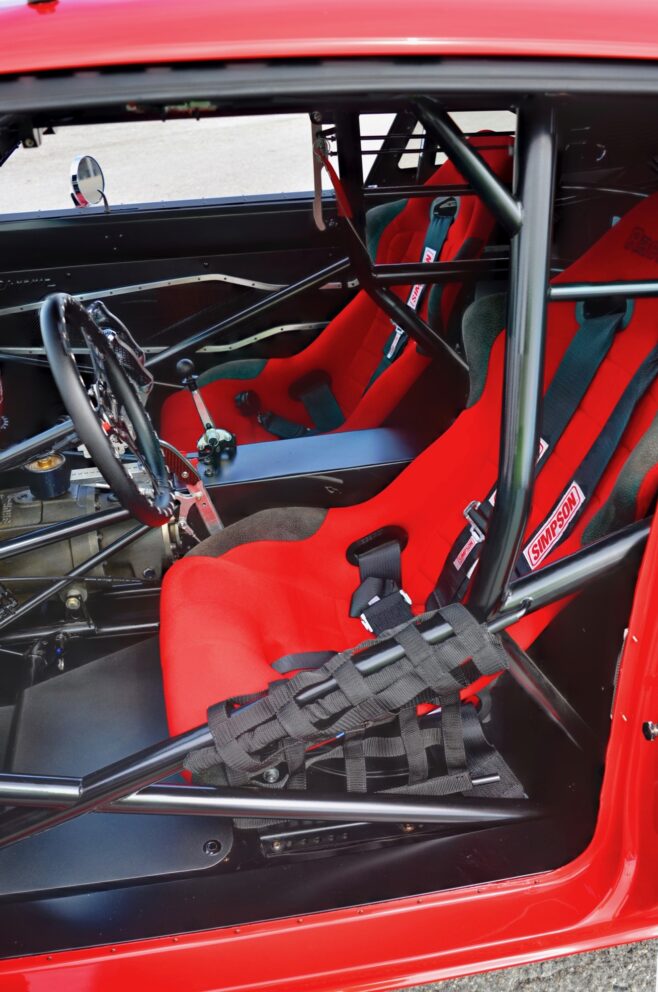
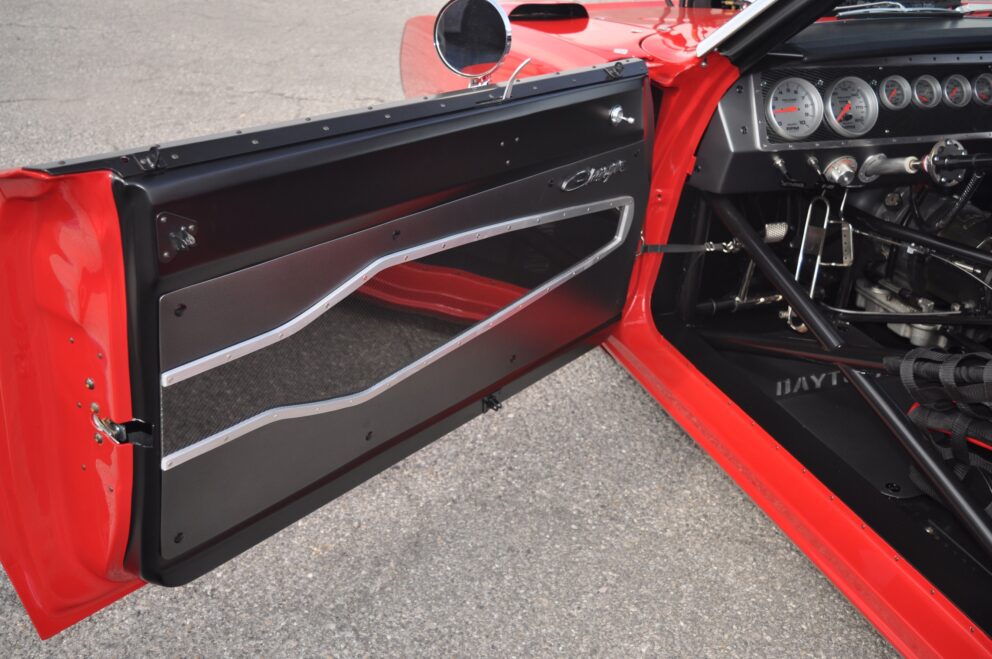
Full protection roll cage with driver Funny Car enclosure, dashboard and door panels fabricated (carbon fiber and aluminum) to mimic original production Chargers. The Lenco 3-speed planetary transmission (with hand-fabricated pistol grips!) and Bruno Converter Drive w/transbrake fully visible. Full Pro-Comp Autometer instrumentation, overhead control console, removable steering wheel, Racetech seats fitted with Simpson Safety harnesses. Super detailed!
THAT HEMI TURNS HEADS!
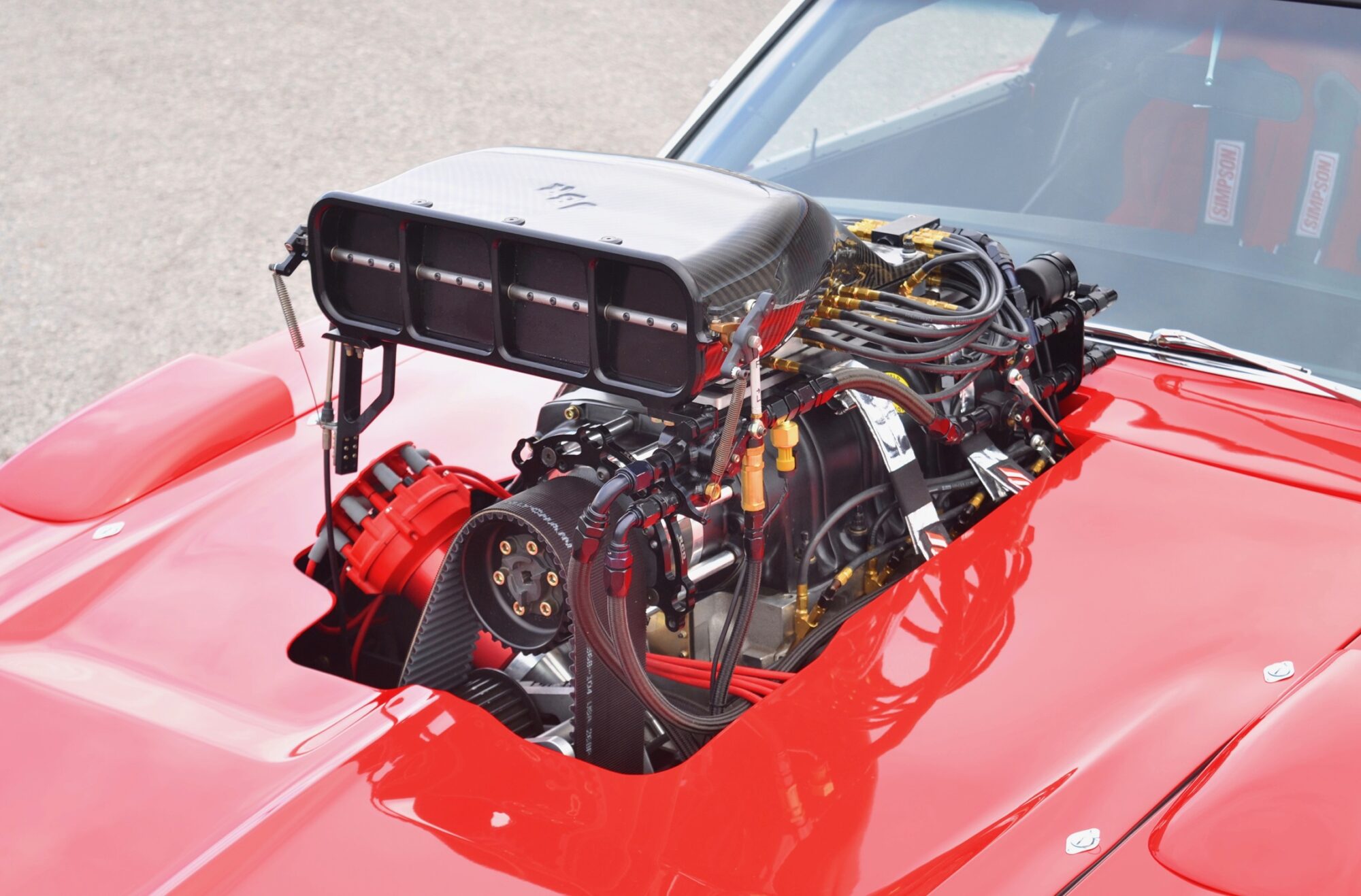
Regarding the initial optics of this outrageous engine, the crown jewel of the assembly has to be that carbon fiber “hat” injector from JBR, it has a 74-square-inch butterfly area when opened and the whole concept behind it is to get as much clean air into the supercharger as possible, to make maximum boost … and its slick design gives it some style!
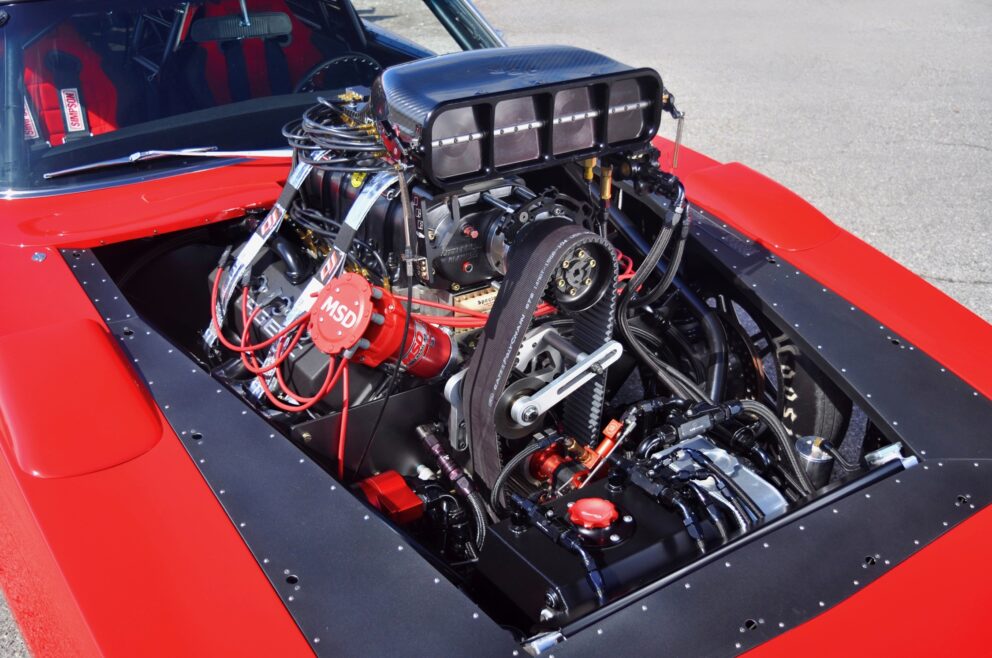
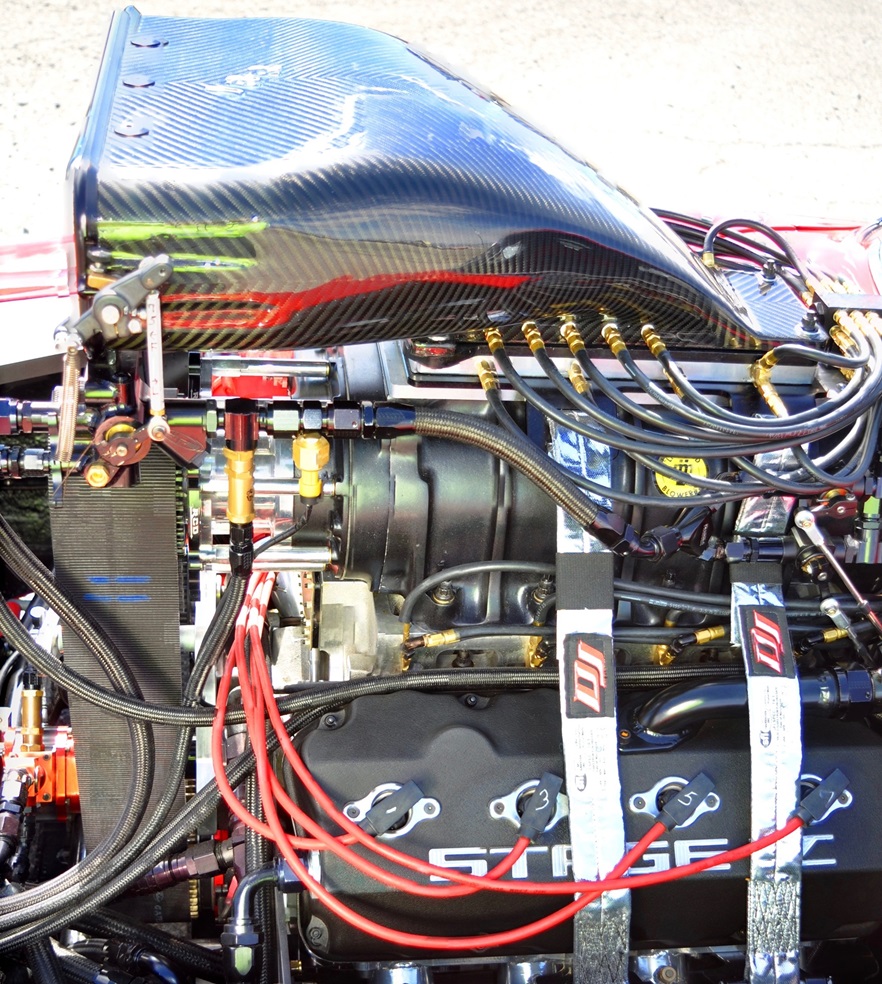
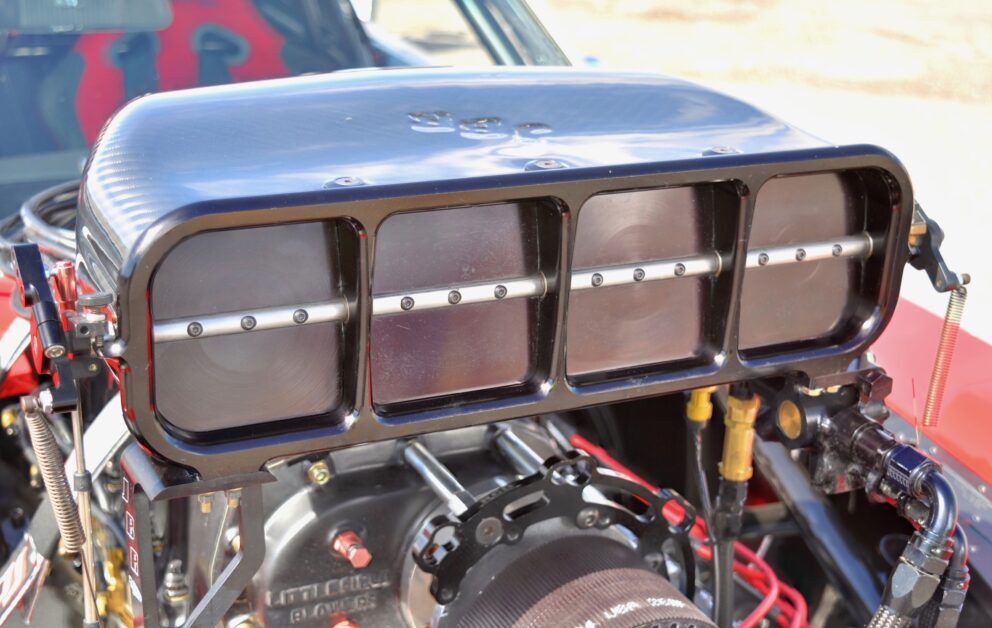
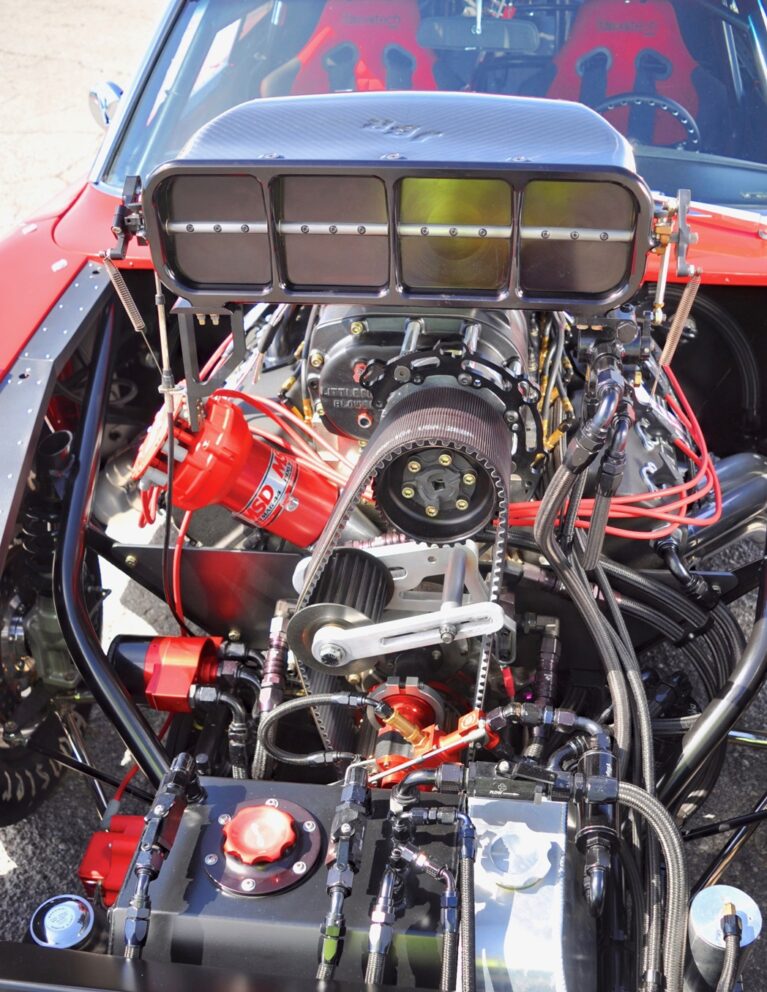
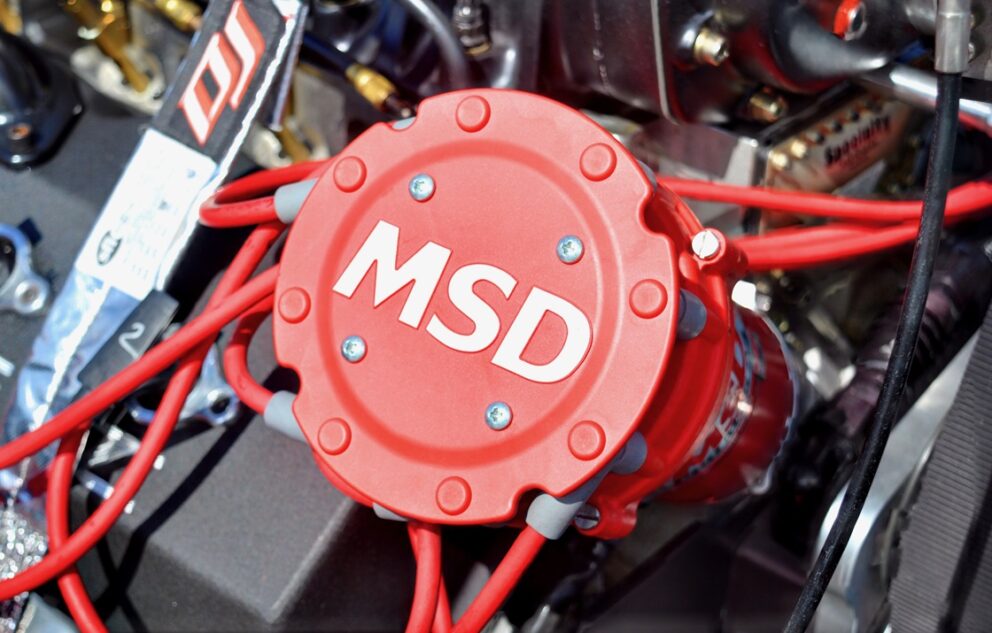
This is a sophisticated, all-out alcohol race HEMI engine and extreme detail work was put into the functionality as well as appearance. MSD supplies spark, currently is 15-percent overdriven (idles at a nice 1,300 rpms!) and the blower straps are there as mandated by Pro Mod rules. 4-inch-wide blower belt and drive setup, Waterman “Lil Bertha” racing mechanical fuel pump, and inside the cabin the fuel can be quickly changed from methanol to E85 fuel. It’s a mechanical marvel just to look at from any direction!
DAYTONA STRIPE IN PAINT
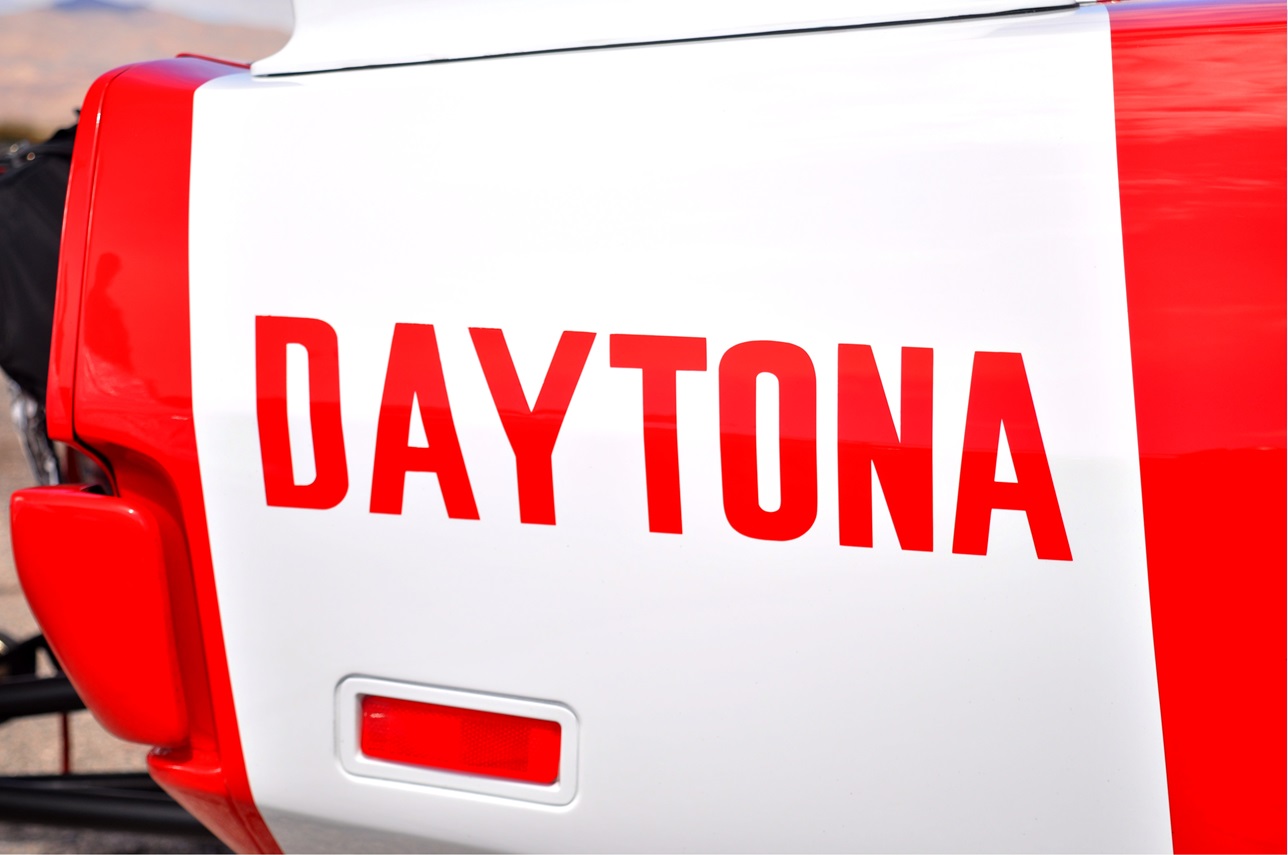
When it came time to put on the Daytona stripe, Wally did it in paint rather than decal: “I used an original stripe decal and scanned it into my computer, then printed out the lettering on my Kricut machine to make stencils.”
DETAILS MATTER!
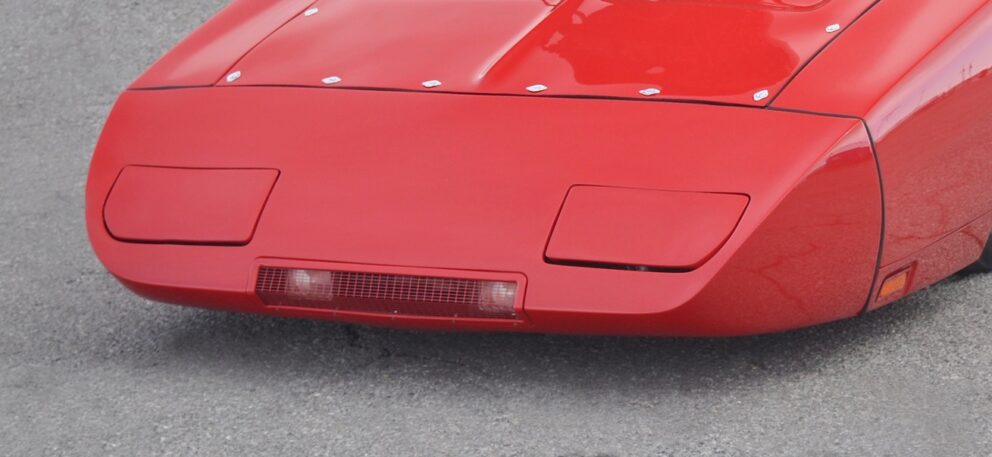
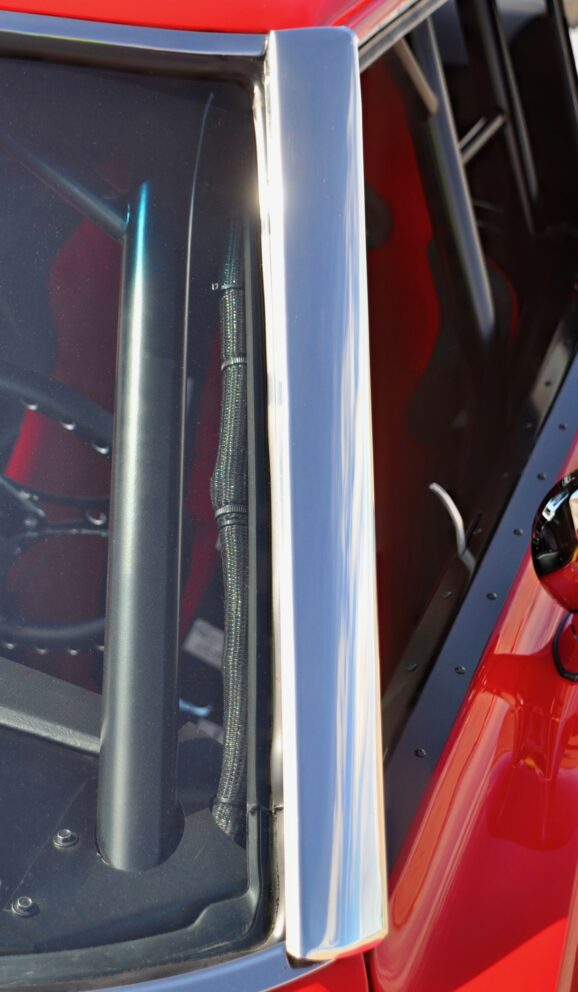
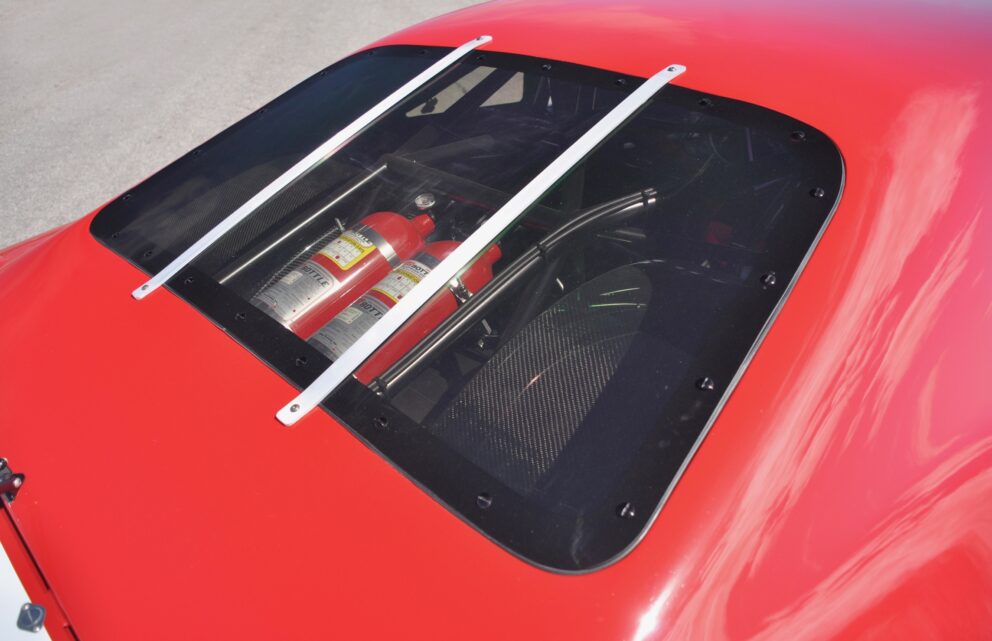
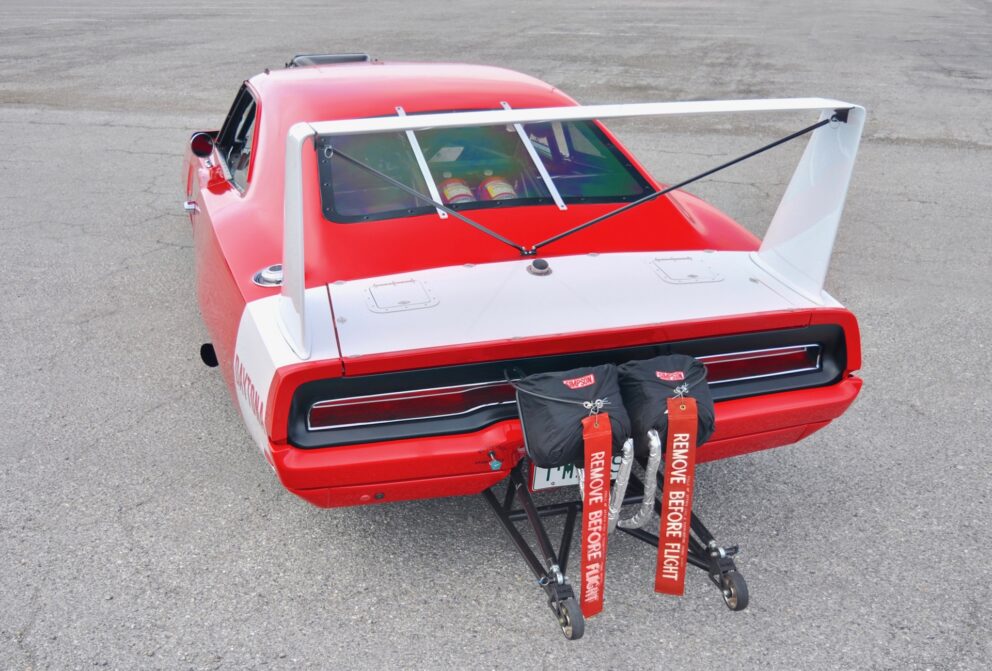
Daytona nose cone, CO2-operated swivel headlights, correct air inlet grille, A-pillar covers, as well as the placement of the front fender rear-facing scoops. It has a correctly fabricated rear window plug, and yes, the massive rear wing! Because of the speeds it will see on the drag strip, plus as a result of the wing produced in fiberglass as opposed to the aluminum originals, it was felt some additional bracing struts would add any needed strength.
HONORING THE PENTASTAR
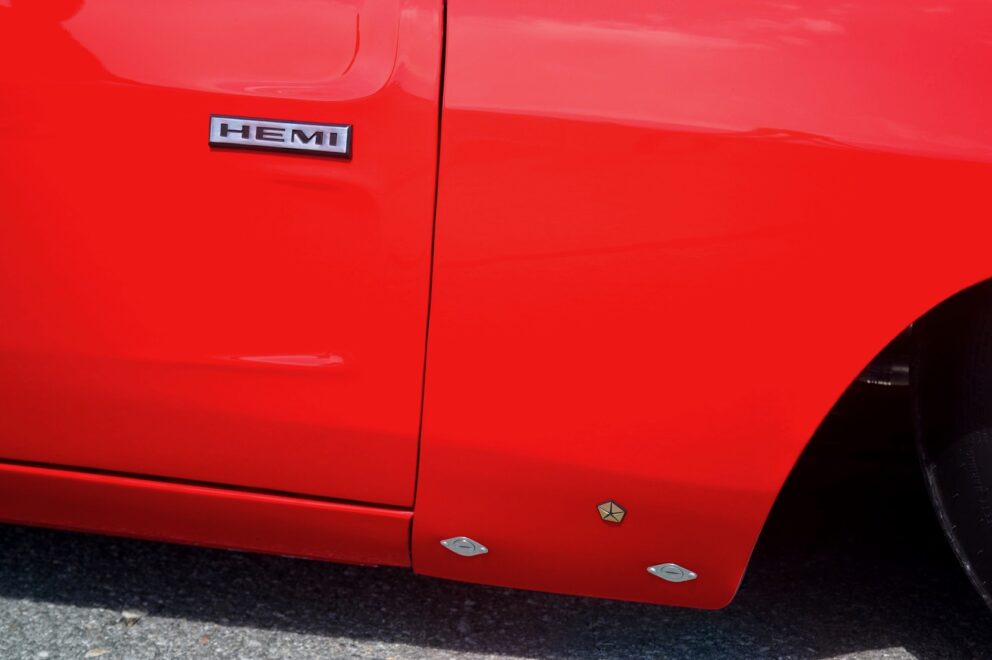
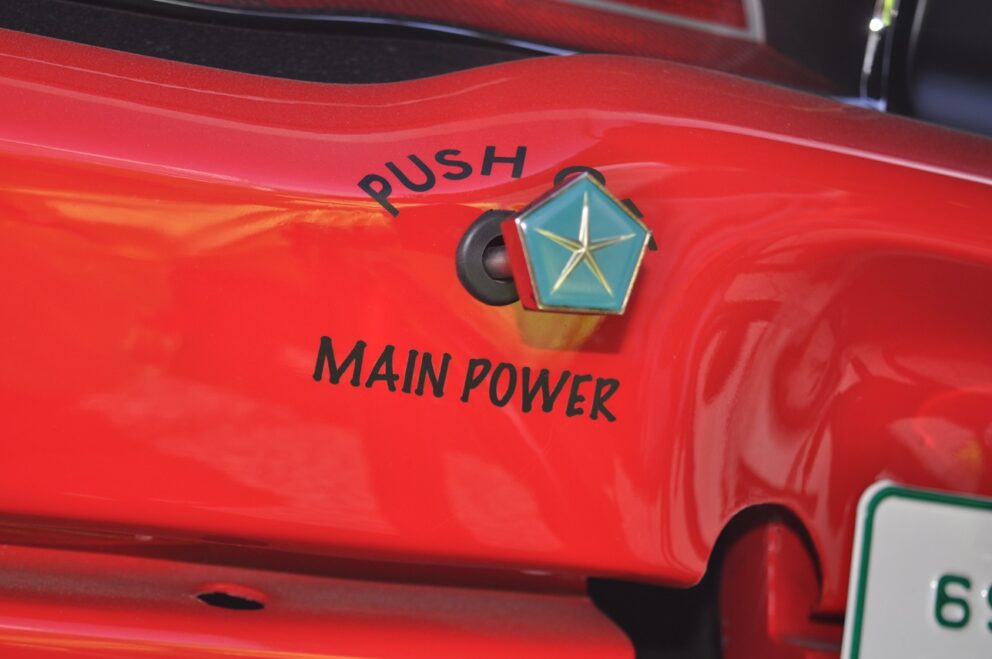
It was 1962 when then Chrysler President Lynn Townsend put forth the idea of creating a single logo that would represent all the various Chrysler vehicles and worldwide divisions, the logo “Pentastar” and its five triangles was chosen, arranged so their bases formed the sides of a pentagon. Simple and easily recognizable, the Pentastar logo (in gold) was placed on the lower front fenders (passenger’s side) of Chrysler cars from 1963 into the 1972 model year. Anyone who was into Mopar vehicles, like Wally Elder, knew all about this visual feature, and when he did up his Daytona, he made sure one of the these Pentastar logos was placed, correctly, on the car. Also, as a further tribute to the famous logo, he added one to the push-pull power switch on the rear bumper. Nice touch!
STREET LEGAL
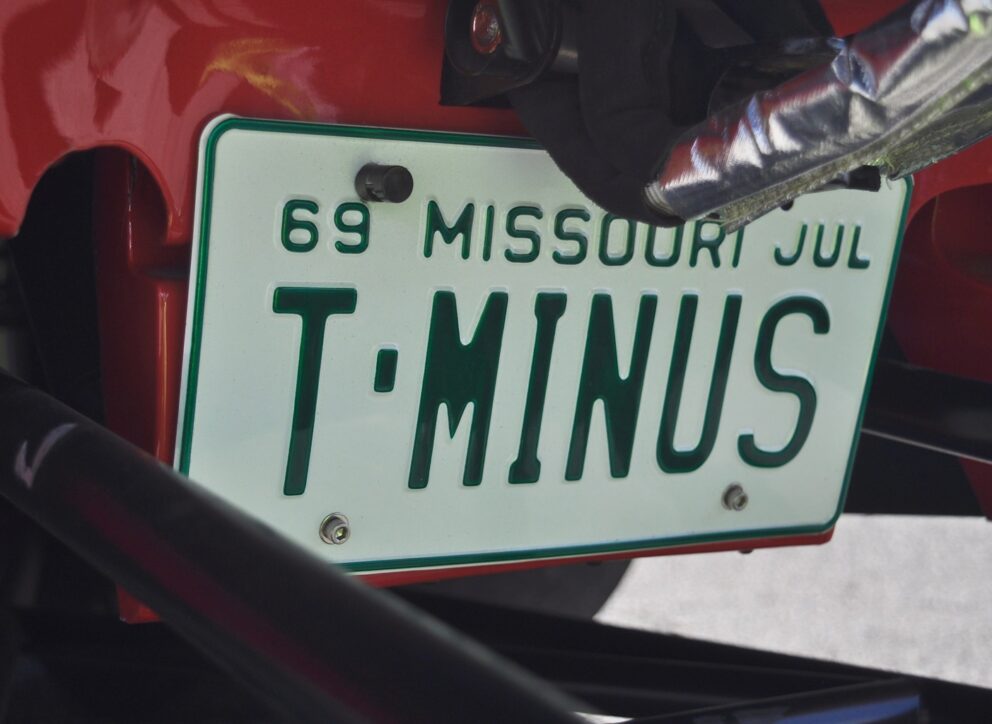
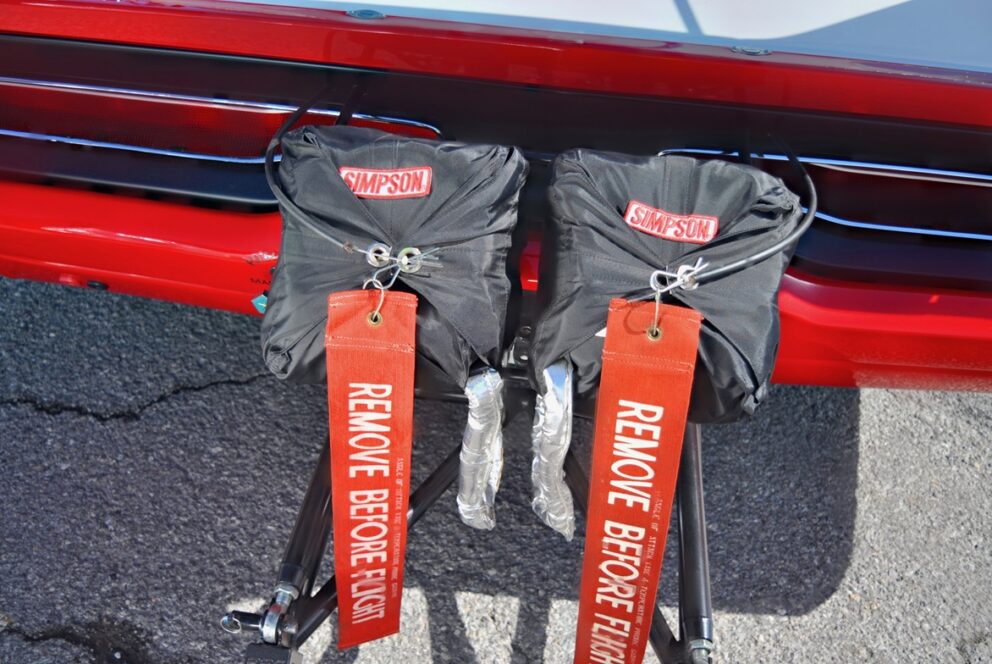
The whole theme of this HEMI Daytona machine was to, yes, build an over-the-top, wild high-horsepower vehicle that had the looks to turn heads, all the while the car has the necessary equipment to pass the State of Missouri Safety Inspection to be driven on the streets and highways.
And when the time comes that he decides to take it out on the drag strip, those twin Simpson Safety Equipment parachutes aren’t there just for looks…!!
WALLY’S FIRST VERSION
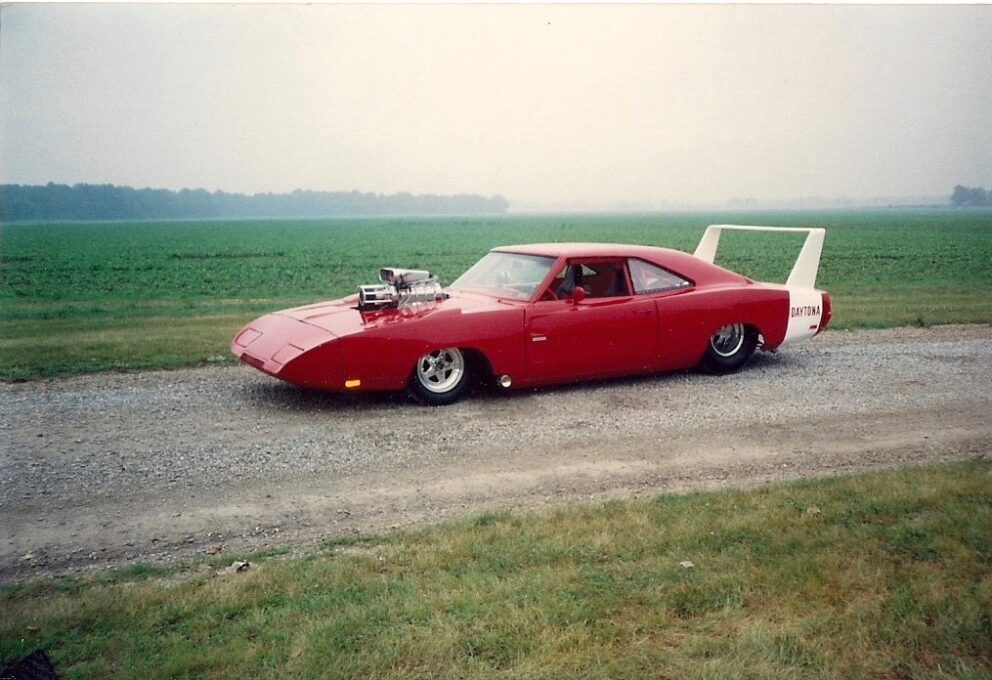
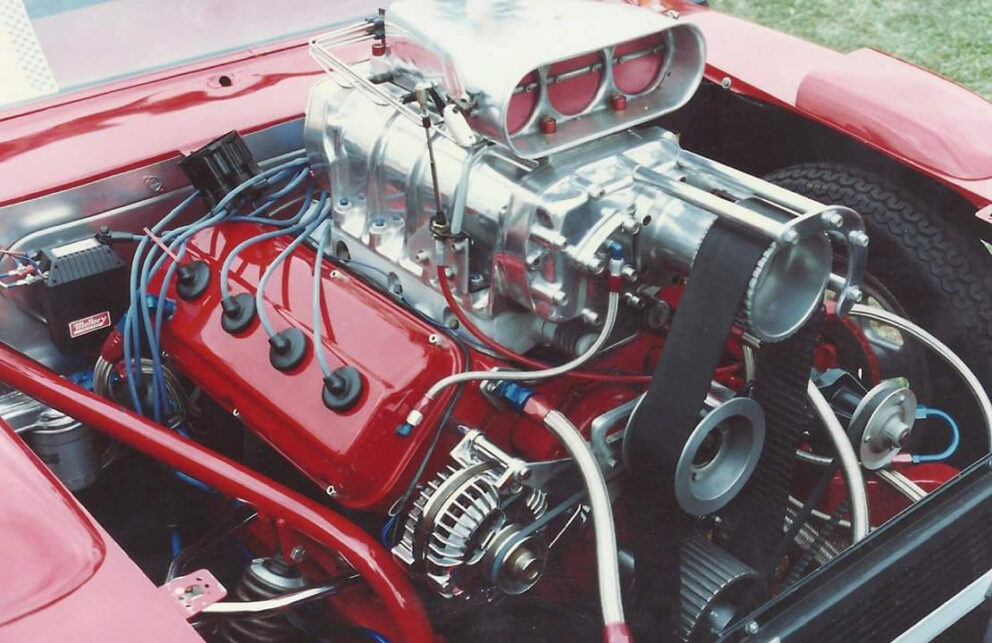
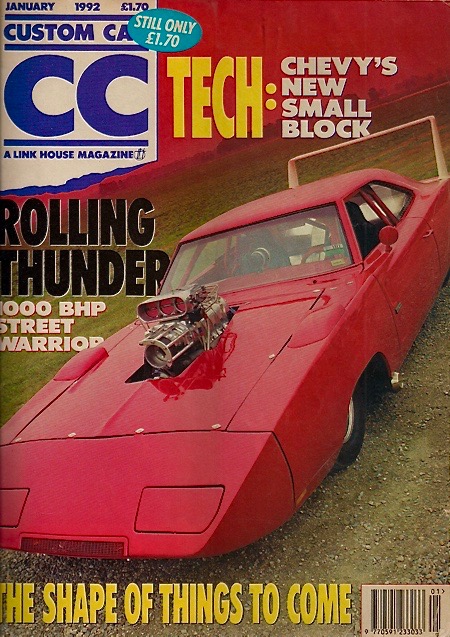
Oh yeah! It too was a wild creation, tube chassis, blown GEN I HEMI engine, slammed to the ground. It was cover car material all the way; and for 1991, it was a very radical build that got noticed worldwide! Had Wally been able to buy it back, well, the Mopar world now has two of these beasts!
VIVA LAS VEGAS (AT THE STRIP!)
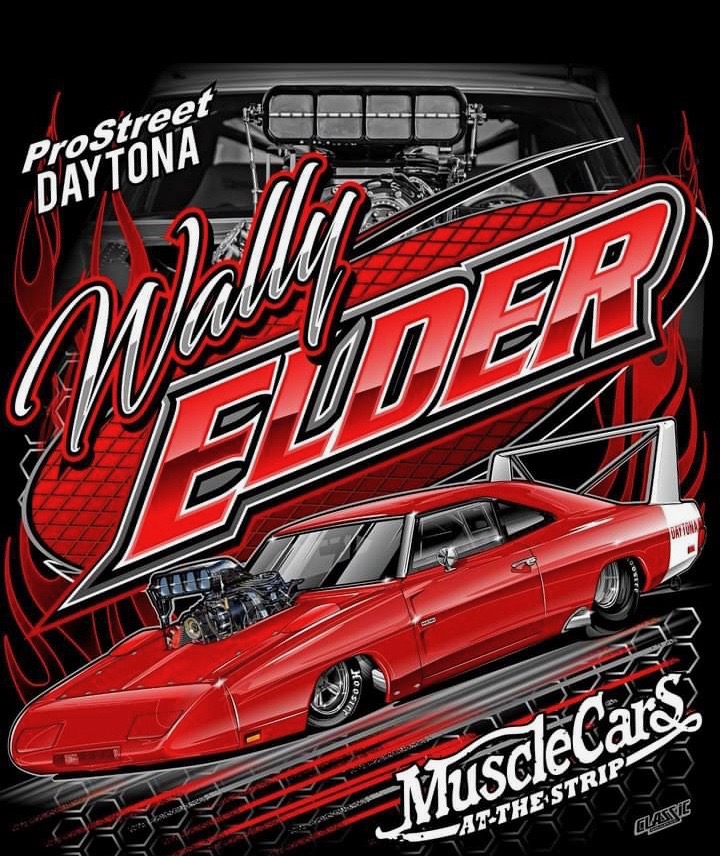
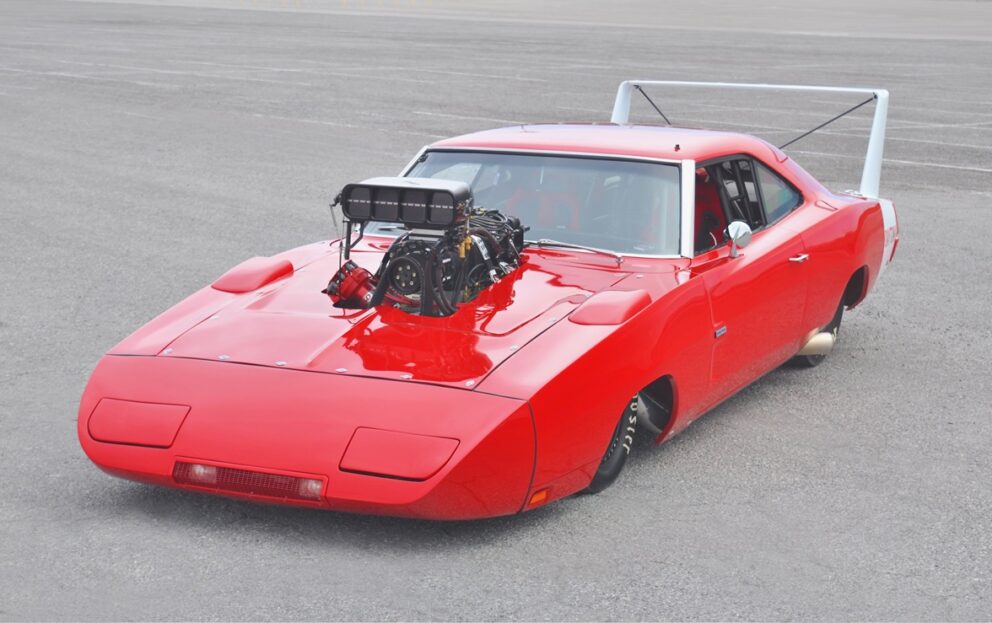
To celebrate the showing of the car at the 2024 “Muscle Cars at the Strip” Las Vegas event, a commemorative T-shirt was designed for the wild winged Extreme Pro Street that Wally Elder put together over a six-year time period. The event was fabulous, Phil and Jill Painter did yet another fantastic presentation and while it was filled with a wide variety of show and race vehicles, to anyone that saw (or heard!) this impressive street pounder, it’s something not soon forgotten.
Author: James Maxwell
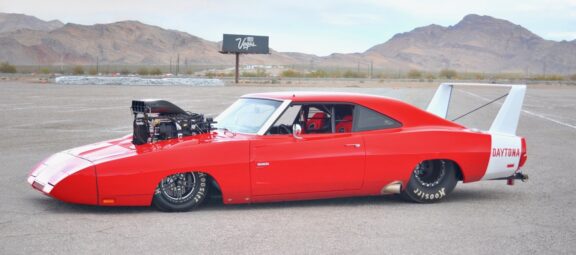
0 Comments